Venezuela, Los Roques: A Trip Worth the Effort
Florian and Vicki Grassl of SY Ibex had always wanted to visit Los Roques, a group of islands about 120NM off the coast of Venezuela, due north of Caracas, but were unsure about visiting in COVID-19 times. They decided to go anyway from Grenada and say it was well worth the effort.
Published 3 years ago

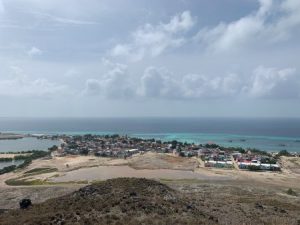
- Grand Roques from the hills behind the town.
Our Experience
Los Roques was always on our list of places we wanted to go to, but were truly unsure whether we should dare it in times of Covid, given that it was almost impossible to find accurate and up to date information.
We got lots of naysayer feedback, regarding “not open”, “too complex”, “too expensive”, “too dangerous”, “not possible to enter a next country thereafter” – but none of this feedback was from people who had actually been there recently.
By social media we found only two yachts who had been there recently in June and July respectively (2021) and they had both had a very good experience. Our main issue was not knowing whether Los Roques would be open the week we needed to enter (at the time it was opening alternate weeks). So we extrapolated from the June/July info. and hoped they did not change the system – they did not, and we were lucky.
Entry Formalities
Entry formalities were a bit more complex than in the West Indies, but no more complex than in other Latin American countries. See the detailed description below of our experience with the five authorities we had to visit. Even the language barrier (they don‘t speak English, we don’t speak any Spanish) did not present a significant problem. After 2-3 hours we were cleared in and ready to go.
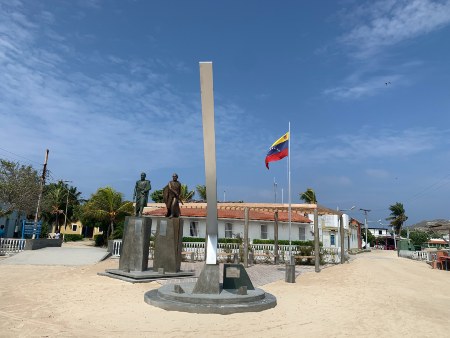

Getting to know Grand Roque
We spent two days on Grand Roque itself. Many visiting yachts try to get to the smaller islands fast, but we felt getting to know Grand Roque and its people was all part of the experience – we still think this was well worth it. Grand Roque is a simple place, no cars, streets are sand, electricity available only a few hours a day, cash only, no ATM, no credit cards accepted, limited grocery supplies, etc. But all the people we met gave us a warm welcome, were friendly and super helpful.

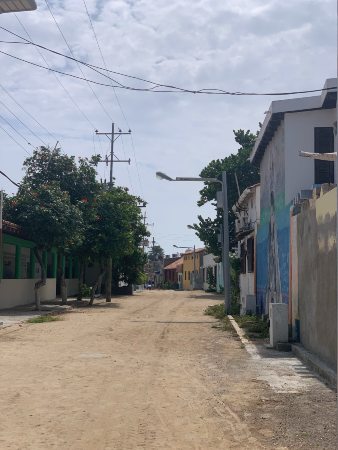
- Streets of sand and no cars!
We finally found 2-3 people who spoke English and learned more about the village, how the people live, how the domestic tourism business with the Venezuelan people from the mainland works, where they get their water from, etc. The domestic tourists stay primarily in “posadas“ (lodges) on Grand Roque and are brought by small open boats to a few of the beaches during the day.
There are a handful of local yachts (one catamaran and a few trawlers), who take charter guests, mostly domestic as well.
The remainder of the two weeks we spent on the smaller outlying islands, most of which are totally uninhabited. On a few there is a single bar / restaurant or another “posada“ (lodge) – all very simple. But most of the islands are just sand, grass here or there, mangroves or a few palm trees and lots of reefs. Eyeball navigation is a must, available charts are helpful in principle, however in detail inaccurate and some areas have not even been surveyed.
We used the old (not updated since then) Doyle Guide for Venezuela/Bonaire from 2006 and found the descriptions of how to enter the different anchorages very helpful, paired with doing our own eyeballing (forget anything in the guide regarding formalities or practicalities, that’s all outdated). We have a 2.1m draft and had no issues with the places we visited.
Easy Sailing between Islands
We anchored at Grand Roque, Crasqui, Sarqui, Dos Mosquises, Cayo de Agua and Francisqui, and visited a few more islands by dinghy. The sailing was easy in 10-20kts of wind but in calm seas – sheltered by the outer reefs. There are only short distances between the islands. Everything else is pure enjoyment as well: long sand beaches, reefs to explore, lots of fish, turtles, stingrays and lobster.
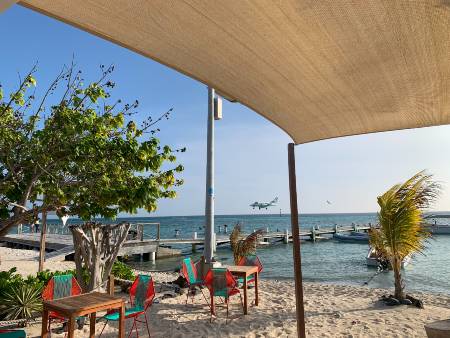

The southern island of the Dos Mosquises has a turtle nursery and some display boards on the history of the Amerindians, who lived there before the Spanish seafarers arrived. Nowadays, there are two or three people living on that island, who take care of the turtle nursery and who were happy to show us around. Overall we met only two other foreign sailing yachts during our stay and had most of the islands entirely to ourselves. A trip well worth the effort.
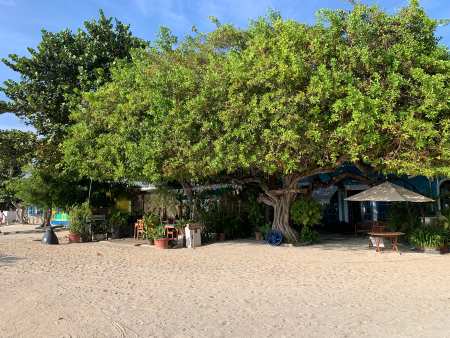
Los Roques – Our Experience with Formalities and Practicalities
Please be aware that things on Los Roques seem to change fast, even outside of Covid implications, so this information simply describes our own experience.
Context: we sailed from St George / Grenada for 51 hours and arrived and cleared in on Friday, October 29th. We left on Thursday, November 11th for Bonaire; we are Austrians/EU, and our boat is registered there.
Covid status: in general, the Los Roques are “Open“, we would not know about the rest of Venezuela. Specifically, Los Roques had alternating open and so called “radical“ or closed weeks, i.e. it was only possible to enter every other calendar week. The week starting Oct 25th was an open week, so we could enter on Oct 29th. This policy was then changed by a decision on 25th October, to suspend that approach for two months, i.e. during Nov and Dec all weeks are open weeks. While some local people say, they expect, that by January there would be the alternating week thing again others just say it is unclear what happens in January.
Covid entry protocol: by bringing a negative PCR test from our departure port (Grenada), we could clear in without any further testing or quarantine, etc. We are fully vaccinated, but no one checked on that. We have heard there is even a possibility to test on arrival, i.e. entering without a negative PCR test from the departure port, but we did not take that option, so do not know whether or how it would work out in practice.
General entry: we were given permission to stay for 14 days, which we believe is the usual timeframe sailors are allowed to stay
Entry process: in general we believe that the details of the entry process as well as the fees to be paid depend on the individuals on duty at the various authorities. We know from two other boats, one was on Los Roques in June and one in July 2021 and we also checked the process on Noonsite. Each of the stories, including our own is somewhat different and the fees vary, so it is likely that your experience will be different too. Nevertheless, it was not a problem and here is our specific experience of Grand Roque.
Arrival at Grand Roque
We arrived around 7am and anchored off the north-western most jetty, a blue colored floating jetty. After getting the boat ready and having some breakfast we started the entry process at around 9:30am, which consisted of five steps – we did not have / need a visa or an agent.
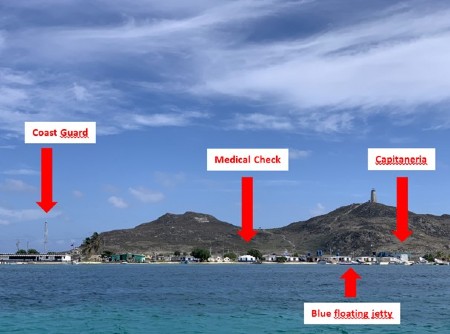

- Medical check: We took the dinghy to the appropriate jetty and by coincidence first talked to the guys who do the medical check. They wear orange T-Shirts and are found in an igloo shaped building with white top and blue bottom, just a bit NW from the jetty. It turned out it is the first authority to visit in sequence. They checked our neg PCR test from Grenada and stamped it, no fees.
- Capitaneria: Next we had to go to the harbor master (“capitaneria“), located in an elevated container just SE from the jetty, he first checked the stamped PCR test, then let us in. He did the paperwork, completed and stamped a spanish form, told us we are allowed to stay up to 14 days and he could do the exit paperwork as well at the same time if we paid 20USD. (the extra paperwork is to fill in the exit date in the same form). We did not get a receipt for the 20USD, but the amount seemed in line with what we have heard from others.

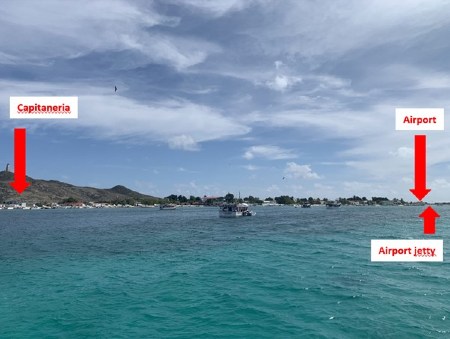
- Guarda Costa: from the capitaneria we were sent to the coast guard. This is located in a larger building further NW from the medical check “igloo” – a white building with the highest antenna mast on the shoreline, the building has “guarda costa“ written on it and it can be seen and read with binoculars from the anchorage. The guy did some paperwork, i.e. entry into his book, checked our papers, including the one from the capitaneria, but we did not get any further paper or paid any fees. The guy stated he would visit us the following day on our boat for a “maritime security check“, but never showed up
- SAIM: the next stop was the SAIM office at the airport (walking distance at the other end of the village, or take dinghy to the airport jetty). We paid the administration and park fees there and got a little flag to fly to show we have paid the park fees. We paid in total 265USD for 2 people, 14 days, 42ft boat. We have heard from others that they paid different amounts here for the same number of people, duration or stay and boat size, not sure where the difference comes from, but we did get a receipt stating the exact amount we paid. We heard from others, that they were able to pay with a credit card, but this was not possible for us (could be due to a – quite common, more or less daily – electricity outage)
- Immigration: right next to the SAIM office at the airport, they stamp the passports and issue inbound clearance. We were told we need to pay a fee of 3 petros, a virtual currency, which was then calculated into bolivar and from there to USD which turned out to be 168USD for two people, for entry and exit. This is more than we have heard from others, but we did not get an explicit receipt other than the clearance paper (which does not state the amount paid). It did not feel like bribe money, but then, there was not really an alternative either. We have heard from other people, that they were able to get the entry and exit stamp at the same time. We asked for this specifically and were told, that this is illegal (the exact word was used) and that we should come back two to three days before we wanted to leave.
Friendly and Helpful People
In general, everyone was very friendly and helpful, people on the street would help us find places, etc.. We do not speak Spanish other than a few words like hello, thank you, etc., none of the officials spoke English and none of the people we met on the street. With the medical guys we just spoke “hand signs“, the harbor master called an English-speaking lady to be a translator for us, the coast guard guy knew a few words in English, the rest was sign language again. At the SAIM and immigration offices they used google translate to “talk to us”. In total we were done after 2-3 hours.
Exit process
We went back to immigration two days before we left, got our passports stamped, no further fees. As we got the inbound clearance there, we expected to get an outbound clearance, but that was not the case, for that they sent us back to the Capitaneria. We were surprised about that, as we paid the 20USD there to cover the exit as well, but had no paper which stated “outbound clearance” (while the inbound paper was explicit in that regard). Back at the Capitaneria, the harbor master simply shrugged, took the form he issued us originally, turned it, made a handwritten note in spanish that we are authorized to leave on a given date to Bonaire and stamped it. We still had no paper which stated “outbound clearance“ or ZARPE, but no one cared in Bonaire either, they made copies of the papers we had, with no further questions.
Covid / PCR testing for departure / next country
We have checked with the aforementioned medical guys, the ambulatory as well as at the airport. To the best of our knowledge it is NOT possible to do a PCR test on the island, they only do antigen tests. We were told this would be free of charge at the ambulatory. At the airport the fee is be 80USD (and then they bring the swab to the ambulatory). This means if ones next country is a country in general requiring a departure PCR test from the last port, one needs to check with them for an exception or choose a different country as next port (Bonaire does require a departure PCR test from previous port, but when asked specifically, they told us we could also do one upon arrival in Bonaire, they just do not announce that option widely).
Money
The island is USD cash only, no other currency, no ATM, no bank, no credit cards accepted (unless you are lucky at SAIM office as some others were). Change is hard to come by, so bring as many small denomination bills as possible.
Mobile Network
There is mobile network coverage, if you have a SIM card that works in Venezuela (locals told us it is a slow network though). It was not possible for us to buy SIM cards. There is a store which sells SIM cards from time to time, if they have some, but not during the time we were there (we checked multiple times). The store has “Movistar” written on it and is opposite of the “Frank Louis” grocery shop (everyone knows it, just ask!).
WiFi
This is hard to come by, there are only few lodges/bars with WiFi. We used the WiFi from Posada Galapagos for our most important emails and paid a few dollars, sending 400KB of attachments for our Bonaire entry took about an hour.
Provisioning
Bring everything you need, there are a few grocery stores and bakeries on the island, but food is expensive and availability depends on the day relative to supply ship arrival. On some days, there is a small fruit/vegetable market at the “new” basketball court (it is the large high red roof seen from the anchorage).
Other suppliers
There is no diesel available.
Dinghy gas could be available from time to time, but we have heard it is bad quality.
Don’t expect to be able to get any boat parts or supplies.
Florian and Vicki Grassl
SY Ibex

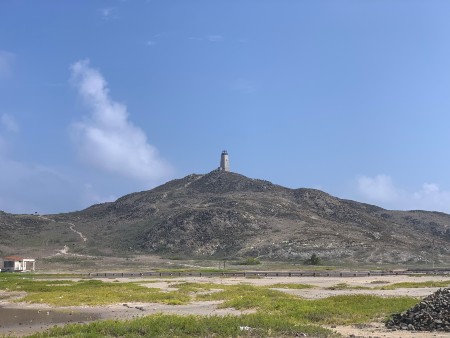
- The Landscape of Grand Roques
………………………………………………………………………………………………………………………………………
About the Authors
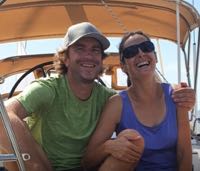

More detailed stories can be found on their blog -both in German and English: www.sailing-ibex.com
………………………………………………………………………………………………………………………………………
The opinions expressed in this article are the author’s own and do not reflect the view of Noonsite.com or World Cruising Club.
Related to following destinations: Los Roques, Venezuela
Related to the following Cruising Resources: Caribbean Sea, Cruising Information, Routing



